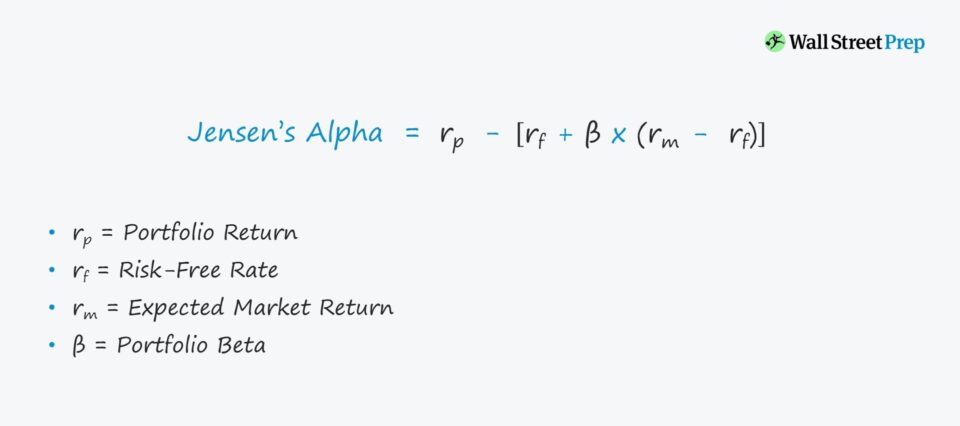What is Jensen’s Measure?
Jensen’s Measure quantifies the excess returns obtained by a portfolio of investments above the returns implied by the capital asset pricing model (CAPM).

Jensen’s Measure Formula
In the context of portfolio management, alpha (α) is defined as the incremental returns from a portfolio of investments, typically consisting of equities, above a certain benchmark return.
Under Jensen’s Measure, the chosen benchmark return is the capital asset pricing model (CAPM), rather than the S&P 500 market index.
The formula for alpha under Jensen’s Measure is shown below:
Jensen’s Alpha Formula
Jensen’s Alpha = rp – [rf + β * (rm – rf)]
- rp = Portfolio Return
- rf = Risk-Free Rate
- rm = Expected Market Return
- β = Portfolio Beta
How to Interpret Jensen’s Alpha
The value of alpha – the excess returns – can range from being positive, negative, or zero.
- Positive Alpha: Outperformance
- Negative Alpha: Underperformance
- Zero Alpha: Neutral Performance (i.e. Tracks Benchmark)
The CAPM model calculates risk-adjusted returns – i.e. the formula adjusts for the risk-free rate to account for risk.
Therefore, if a given security is fairly priced, the expected returns should be the same as the returns estimated by CAPM (i.e. alpha = 0).
However, if the security were to earn more than the risk-adjusted returns, the alpha will be positive.
By contrast, negative alpha suggests the security (or portfolio) fell short in achieving its required return.
For return-oriented portfolio managers, a higher alpha is nearly always the desired outcome.
The Wharton Online & Wall Street Prep Applied Value Investing Certificate Program
Learn how institutional investors identify high-potential undervalued stocks. Enrollment is open for the Feb. 10 - Apr. 6 cohort.
Enroll TodayJensen’s Measure Calculation Example
Now, to move to an example calculation of Jensen’s alpha, let’s use the following assumptions:
- Beginning Portfolio Value = $1 million
- Ending Portfolio Value = $1.2 million
- Portfolio Beta = 1.2
- Risk-Free Rate = 2%
- Expected Market Return = 10%
The first step is to calculate the portfolio return, which can be calculated using the formula below.
Portfolio Return Formula
- Portfolio Return = (Ending Portfolio Value / Beginning Portfolio Value) – 1
If we divide $1.2 million by $1 million and subtract one, we arrive at 20% for the portfolio return.
Next, the portfolio beta was stated as 1.2 while the risk-free rate is 2%, so we have all the necessary inputs.
In closing, the estimated alpha for our example scenario is equal to 8.4%.





